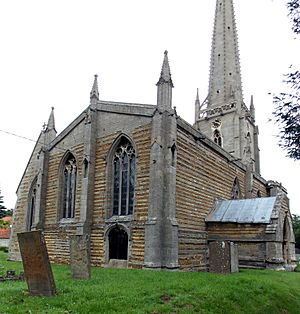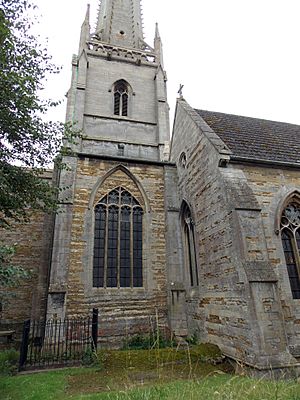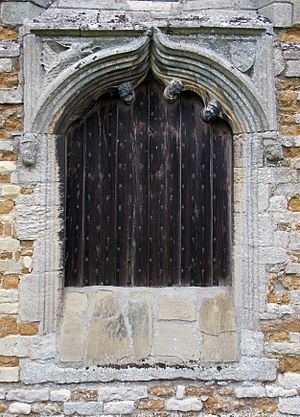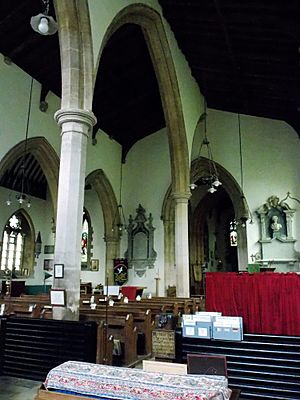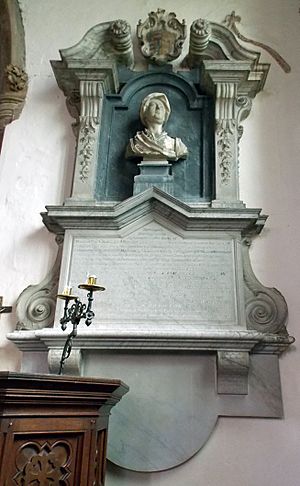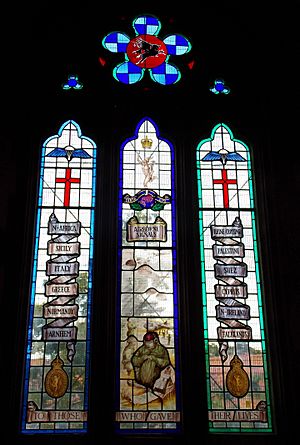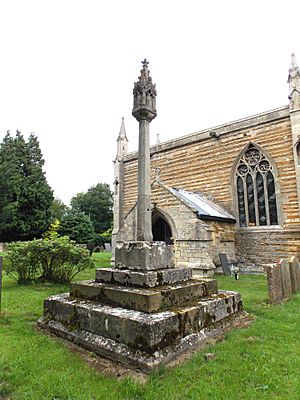St Vincent's Church, Caythorpe facts for kids
Quick facts for kids St Vincent's Church, Caythorpe |
|
|---|---|
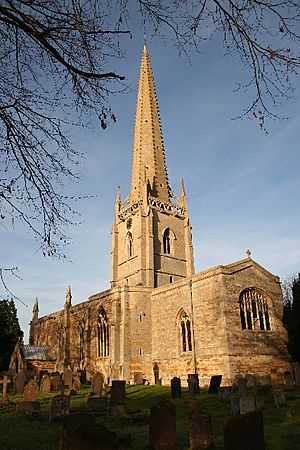
Church of St Vincent, Caythorpe
|
|
| 53°01′34″N 0°36′06″W / 53.026155°N 0.60166365°W | |
| Country | England |
| Denomination | Church of England |
| History | |
| Founded | 13th century |
| Dedication | Vincent of Saragossa |
| Architecture | |
| Heritage designation | Grade I |
| Designated | 20 September 1966 |
| Architectural type | Decorated, Perpendicular |
| Specifications | |
| Spire height | 156 feet (47.5 m) |
| Materials | limestone, ironstone, rubble |
| Administration | |
| Parish | Caythorpe |
| Deanery | Deanery of Loveden |
| Diocese | Diocese of Lincoln |
| Province | Canterbury |
St Vincent's Church is a very old and important church in Caythorpe, England. It is a Church of England parish church, meaning it serves the local community. The church is located near the Lincoln Cliff, about 10 miles (16 km) north of Grantham.
This church is special because it is one of only four churches in England named after Vincent of Saragossa. It is also famous for having a double nave, which is very rare, with only four existing in England. Inside, you can find memorials to important people like Sir Charles and Sir Edward Hussey, and to the 18th-century astronomer Edmund Weaver.
St Vincent's Church is part of the Caythorpe Group of churches. This group includes St Nicholas' at Fulbeck and St Nicholas' at Carlton Scroop with Normanton.
Contents
Church History and Building
Early Beginnings and Construction
Records from the 11th century, like the Domesday Book, show that there were two churches in Caythorpe. The current church building was mostly built in the early 14th century. Lady Elizabeth de Burgh, a niece of King Edward II, likely helped fund its construction. The Knights Hospitaller, a medieval religious order, originally supported the church.
The church's official records, called the parish register, began in 1663 for baptisms, 1692 for marriages, and 1673 for burials. The first recorded rector (parish priest) of Caythorpe was Christopher Mallam in 1551.
Lightning Strikes and Rebuilding
On December 30, 1859, lightning struck the church's spire. The top part of the spire fell through the roofs of the chancel and transepts. The spire was rebuilt in 1860 by George Gilbert Scott, a famous architect known for his Gothic Revival style. The new spire was made 10 feet (3 m) shorter but was considered more graceful. At the same time, a north aisle was added to the nave, also designed by Scott. The spire was hit by lightning again in 1937, but luckily, no damage occurred that time.
Inside the Church: Art and Music
Above the west arch inside the nave, there used to be parts of 'Doom paintings'. These murals showed the Last Judgment and the Archangel Michael weighing souls. They were damaged by the 1859 lightning strike and later covered with whitewash in the 1960s because restoration was too expensive. However, traces of them can still be seen.
In 1840, a gallery with seating for 150 people was built. A tower clock and a set of eight "very fine bells" were also added. These bells were recast in 1912.
The church's organ was installed in 1871. By the 1980s, it needed a lot of repair due to woodworm. It was restored in 1986, combining parts of the original organ with another organ from a different church. The refurbished organ was officially dedicated by the Bishop of Grantham.
Lost Treasures and Recognition
In 1947, a 16th-century suit of funerary armour belonging to Baron Hussey was given to St Vincent's. Sadly, in 1997, this armour and other valuable items were stolen from the church and have not been found.
St Vincent's Church was given a Grade I listing by English Heritage on September 20, 1966. This means it is a building of exceptional historical and architectural interest. In 2011, the church received £102,000 from the Heritage Lottery Fund to help maintain its spire and nave roof. The church was temporarily closed in February 2012 after damage to the spire from the 2008 Lincolnshire earthquake was discovered.
Remembering the Military
St Vincent's hosts yearly memorial services for the No. 216 Parachute Signals Squadron. This military unit was stationed in Caythorpe and took part in Operation Market Garden during World War II in 1944. Stained glass windows were installed in the north aisle in 1994 to remember the Airborne Signals (Royal Corps of Signals) and those who died in the 1982 Falklands War and other conflicts.
Church Architecture
Outside the Church
St Vincent's Church is mostly built from limestone and ironstone rubble, with detailed ashlar stone work. It has slate roofs. The church has a cross shape, with a chancel, a double nave, a tower with a spire, north and south transepts, a north aisle, and a south porch. Its construction dates from the 13th to the 18th century, with additions and rebuilding in the 1860s. The style is mainly Decorated and Perpendicular.
The tower is in the middle of the church, where the nave and chancel meet. With its spire, it reaches a height of 156 feet (48 m). The spire has small windows called lucarnes and is topped with a weathervane. The tower also has two clocks and windows on each side. Water drains from the roof through grotesque gargoyles.
The nave walls show a pattern of ironstone and ashlar. On the west side, there are buttresses (supports) with bas relief carvings, including an Annunciation scene. Two large windows from the late 13th century are in the west wall. Below the south window, there is a blocked door from the late 14th century. The south wall of the nave has two large windows and two smaller ones.
The chancel, which is the area around the altar, was largely rebuilt in the 18th and 19th centuries. It has a large stained glass window on the east wall and two smaller windows on the north and south walls.
The north aisle, added in 1860, has a series of windows. Between the windows are buttresses that support the roof. The north transept has a 15th-century window, while the south transept has an older, 13th-century window.
The south porch, built in the 14th century, is made of the same banded limestone and ironstone. Its entrance has a pointed arch supported by pillars. Inside, there are two stone benches. The nave door within the porch has large, decorative iron hinges. Above the door, there is a carving of the Virgin Mary. An old inscription in the porch mentions a grant given to the church to provide 282 seats for poorer inhabitants.
Inside the Church
The most important architectural feature of St Vincent's is its double nave, which is very rare in England. A series of arches supported by three octagonal pillars runs through the center of the nave, reaching up to the roof. The main wooden beams of the nave are likely from the 14th century. A 17th-century poor box is located at the west end of the nave. The simple, hexagonal baptismal font is believed to be very old, possibly 600 years old.
The 19th-century north aisle, also known as The Arnhem Aisle, has another set of arches. This aisle contains stained glass windows dedicated to the Royal Corps of Signals. One window from 1902 remembers George Henry Minnit.
Between the nave and the chancel is a four-arch crossing under the tower, with shallow transepts to the north and south. These arches are from the 13th century. The south transept holds the church sacristy (a room for sacred vessels), and the north transept is a chapel dedicated to the Blessed Virgin Mary.
The chancel has 19th-century stained glass windows. The north window shows Mary Magdalene and the risen Christ. The south window shows two images of Christ and is a memorial to Rev'd Edward Thomas Lewis. The large east window, in a 15th-century style, shows Christ, prophets, apostles, martyrs, and bishops. This window is a memorial to Rev'd Charles Daniel Crofts and his wife.
The church also has valuable items like a 1732 paten (plate) and flagon (jug), and a 1569 silver chalice (cup) with a 1675 cover.
Important Memorials
Many important memorials are found in St Vincent's Church. Two significant ones are dedicated to the Hussey baronets: Sir Charles (1626–1664) and his wife Elizabeth, and Sir Edward (c. 1661–1725) and his wife Elizabeth (died 1750). Both memorials are on the east wall of the nave and are made of marble. Sir Charles's memorial features a bust and a plaque with inscriptions. Sir Edward's memorial has a plaque between pillars, topped with an urn and a painted coat of arms. The Hussey family were important supporters of the church.
In the chancel, there is a memorial to Edmund Weaver (1683–1748), a local astronomer and land surveyor.
Plaques on the north wall of the north aisle remember those from the parish who died in the First World War and Second World War. Another plaque honors the men of the 1st Airborne Signals who fought in campaigns in Italy and North Africa. A special plaque describes the dedication of the north aisle to the "men of the First Airborne Divisional Signals who were billeted in the Parish and neighbourhood before flying to Holland in their valiant attempt to establish a bridgehead over the River Rhine at Arnhem. September 17th 1944."
Other memorials in the nave and chancel remember various local people, including rectors, doctors, and families. One memorial is for Pickworth B P Horton, who died at the Battle of Salamanca.
Churchyard Features
In the churchyard, south of the church, stands a 14th-century stone cross with a tapering shaft. A gabled lantern was added to it in 1906. This cross is a Grade II listed structure and a scheduled monument, meaning it is protected for its historical importance. It might have been a village market cross in the past.
Just outside the church gates, to the southwest, is the village war memorial. Next to the war memorial, set into the churchyard wall, is a plaque remembering members of the Airborne Signals who died in Operation Corporate during the 1982 Falklands War. This plaque was moved from Aldershot Barracks in 2000. Nearby, there is a boulder brought from the Falkland Islands, with another plaque dedicated to two members of the Parachute Signals who also died in the Falklands War.
Images for kids


